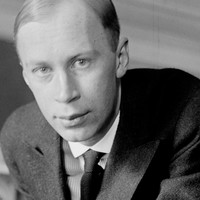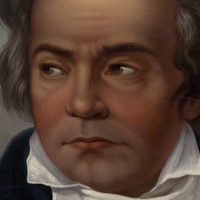Beethoven’s Second Symphony


 Listen to Audio
Listen to Audio
Spending the summer outside of Petrograd in 1917, the 26-year-old Sergei Prokofiev challenged himself to compose without sitting at the piano, and he used Franz Joseph Haydn as inspiration for his svelte First Symphony. This score’s nickname as the “Classical” Symphony is well-deserved, and it served as an early harbinger of the neoclassical trend that swept through modern music in the 1920s.
A leading orchestra in Haydn’s day operated out of the royal court in Mannheim, Germany, and one of their signature moves was the rising “Mannheim Rocket,” which Prokofiev mimicked with the explosive arpeggio that launches his symphony. The second theme, played by the violins as they navigate absurdly wide leaps, shows how effectively Prokofiev used parody and exaggeration to simultaneously celebrate and skewer his source material.
The Larghetto second movement centers on a singing theme that enters in the clear treble of the violins. A contrasting middle section introduces a steady trickle of sixteenth notes, and then the closing passage interweaves both sounds.
Instead of a minuet or scherzo, the symphony turns next to a Gavotte, a staple of French dance suites from the Baroque era. The finale races to the finish on a stream of whirlwind eighth notes, with interlocking rhythmic patterns and seamless handoffs between sections that make for the musical equivalent of a relay race.
Aaron Grad ©2024

Felix Mendelssohn was a teenager when he met Ferdinand David, a virtuoso violinist one year his junior. Later, when Mendelssohn became music director of the Leipzig Gewandhaus Orchestra, he invited David to join the orchestra as concertmaster. In 1838 Mendelssohn suggested to David, “I’d like to write a violin concerto for you next winter; one in E minor sticks in my head, the beginning of which will not leave me in peace.” The piece gestated for six years, until Mendelssohn fleshed it out in the summer of 1844. While writing the work, he corresponded frequently with David about violin technique, even asking for further advice after sending the score off to be published. David debuted the concerto in 1845, accompanied by the Leipzig Gewandhaus Orchestra. Mendelssohn died two years later following a series of strokes, leaving the Violin Concerto as his last completed orchestral work.
Mendelssohn’s Violin Concerto is full of innovations in form and texture, but perhaps its most radical quality comes from what it lacks: gratuitous showmanship. While the violin protagonist certainly encounters technical challenges and brilliant passages, every gesture is at the service of a shared musical discourse with the orchestra. Some of the most magical moments are those that defy conventional responsibilities, as when the violin launches immediately into the brooding first theme, or when it leaves that same melody to the orchestra after the cadenza, instead countering with ghostly arpeggios.
A single held bassoon note links the first movement to the second, blooming into a heartbreaking “song without words” crooned by the violin. As the slow movement recedes, a dramatic transition provides a link to the finale, with the home key recast as a sunny E major. The buoyant material affords ample opportunities for glitzy passagework, while a regal contrasting theme introduces a note of grandeur. It is fitting that this last major theme reworks the rhythms and intervals of the violin’s initial melody: What first appeared in the concerto as a lonely, searing question returns transformed into a knowing answer, expounded together in a mood of communal cheer.
Aaron Grad ©2014
 Listen to Audio
Listen to Audio
(Duration: 34 min)
With his First Symphony, composed in 1800, the ambitious young Ludwig van Beethoven proved that he could rival his onetime teacher, Franz Joseph Haydn, in his signature genre. Two years later, Beethoven went a step farther, using Haydn’s template as a platform for a Second Symphony that was even bolder and more extreme. The backdrop for this pivotal symphony was a terrible change that was overtaking Beethoven in 1802, when his hearing loss progressed to the point that he could no longer hide it. He finished Symphony No. 2 while convalescing in Heiligenstadt, outside of Vienna, where he suffered in a nearly suicidal state of agony, as we know from an unsent letter to his brothers, found among his papers after his death.
Borrowing a feature found in most of Haydn’s iconic London symphonies, Beethoven’s Second Symphony begins with a meaty introduction full of shifting rhythms, moody harmonies and jarring accents. The fast body of the first movement enters, conversely, with just a wisp of melody in the lower strings. Whereas Haydn loved the elegant dichotomy of forte and piano intensities, Beethoven’s score heightens the contrast, calling for even louder fortissimo and even softer pianissimo dynamics.
The Larghetto slow movement contrasts the adventurous opening movement with music that is serene, tuneful and unabashedly beautiful. The melodic phrases introduced by the violins and answered by the clarinets stay within the sweet treble range of female singers, emphasizing the modest, songlike quality of the material.
The third movement brings Beethoven’s inaugural symphonic scherzo (Italian for “joke”), his raucous answer to Haydn’s genial minuets. The running joke here is an echoing pattern in which the last repetition is shockingly robust.
In the finale, a somewhat rough and rude main theme provides much of the comedic fodder. Beethoven’s craftiness is especially evident in the playful ways he works back to that snarling motive.
Aaron Grad ©2023
This concert is part of our complete Beethoven symphony cycle.
Get driving directions and find nearby parking.
Find dining options close to the venue.
View seating charts to find out where you'll be seating.
Get driving directions and find nearby parking.
Find dining options close to the venue.
View seating charts to find out where you'll be seating.
